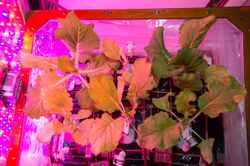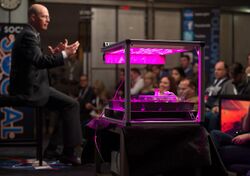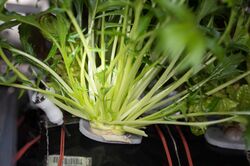Biology:Vegetable Production System

The Vegetable Production System (Veggie) is a plant growth system developed and used by NASA in outer space environments. The purpose of Veggie is to provide a self-sufficient and sustainable food source for astronauts as well as a means of recreation and relaxation through therapeutic gardening.[2] Veggie was designed in conjunction with ORBITEC and is currently being used aboard the International Space Station, with another Veggie module planned to be delivered to the ISS in 2017.[2]
Overview
Veggie is part of an overarching project concerning research on growing crops in zero gravity. Among the goals of this project are to learn about how plants grow in a weightless environment and to learn about how plants can efficiently be grown for crew use in space.[2] Veggie was designed to be low maintenance, using low power and having a low launch mass. Thus, Veggie provides a minorly regulated environment with minimal control over the atmosphere and temperature of the module. The successor to the Veggie project is the Advanced Plant Habitat (APH), components of which will be delivered to the International Space Station during the Cygnus CRS OA-7 and SpaceX CRS-11 missions in 2017.[3]
In 2018 the Veggie-3 experiment was tested with plant pillows and root mats.[4][better source needed] One of the goals is to grow food for crew consumption.[5] Crops tested at this time include cabbage, lettuce, and mizuna.[6]
Design
A Veggie module weighs less than 8 kg (18 lb) and uses 90 watts.[7] It consists of three parts: a lighting system, a bellows enclosure, and a reservoir.[8] The lighting system regulates the amount and intensity of light plants receive, the bellows enclosure keeps the environment inside the unit separate from its surroundings, and the reservoir connects to plant pillows where the seeds grow.
Lighting system
Veggie's lighting system consists of three different types of coloreds LEDs: red, blue, and green. Each color corresponds to a different light intensity that the plants will receive.[2] Although the lighting system can be reconfigured, the following table shows the default settings and their corresponding intensities in micromoles per second per square meter.[2]
| Setting | Red | Blue | Green |
|---|---|---|---|
| Low | 120±10% | 30±10% | - |
| Medium | 240±10% | 60±10% | - |
| High | 360±10% | 90±10% | - |
| On | - | - | 30±5% |
| Potential | 550 | 150 | 100 |
In addition to this lighting system, Veggie also uses opaque bellows to obstruct external sources of light.[2]
Bellows enclosure
The bellows enclosure controls the flow and pressure of air within the container. The bellows are made from a fluorinated polymer and connected to the lighting system at its top and a baseplate at its bottom. Power and cooling is provided to the hardware that powers the bellows by ExPRESS Racks.[2] Although the bellows regulate air flow and air pressure, temperature and humidity are left controlled by the surrounding environment of the Veggie module.[8]
Reservoir
The reservoir of the Veggie module contains and provides water to the plant pillows in which plants grow. The plant pillows contain all other material such as fertilizer and seeds for the plant to grow. Seeds are oriented inside the sticky plant pillow so that their roots will grow downwards into the substrate provided by the plant pillow and that their stems will grow upwards outside of the plant pillow.[9]
Plants grown with Veggie
The following plants have been grown using the Vegetable Production System:
- Red romaine lettuce ("Outrageous" var.)[10]
- Zinnia hybrida ("Profusion" var.)[11]
- Tokyo Bekana (Chinese cabbage)[1]
- Cabbage[12]
- Lettuce[13]
- Mizuna[14]
Results
In 2010, Desert Research and Technology Studies (Desert RATS) performed operational tests of the Vegetable Production System with lettuce. The three lettuce cultivars that were initially planted yielded positive results, growing and being consumed in 14 days. The Desert RATS team reported uniformly positive psychological results from the test crew.[15] No substantial information has been released as of yet on the differences between the nutritional values of space-grown plants and earth-grown plants.
As of August 2015, the Veggie system has succeeded in growing edible plants on the ISS.[9] Further, NASA has announced plans to launch a more advanced plant growth system named Advanced Plant Habitat in 2017.[2] No results have been recorded on the psychological benefits of the Veggie system in space.
See also
- SVET plant growth system
- Bioastronautics
- Plants in space
- Scientific research on the International Space Station
- Space farming
- Astrobotany
References
- ↑ 1.0 1.1 Griffin, Amanda (17 February 2017). "Cabbage Patch: Fifth Crop Harvested Aboard Space Station". NASA. https://www.nasa.gov/feature/cabbage-patch-fifth-crop-harvested-aboard-space-station.
- ↑ 2.0 2.1 2.2 2.3 2.4 2.5 2.6 2.7 Massa, G. D.; Wheeler, R. M.; Morrow, R. C.; Levine, H. G. (2016). "Growth Chambers on the International Space Station for Large Plants". 8th International Symposium on Light in Horticulture. 22–26 May 2016. East Lansing, Michigan.. KSC-E-DAA-TN29529. https://ntrs.nasa.gov/archive/nasa/casi.ntrs.nasa.gov/20160006558.pdf.
- ↑ Herridge, Linda (2 March 2017). "New Plant Habitat Will Increase Harvest on International Space Station". NASA. https://www.nasa.gov/feature/new-plant-habitat-will-increase-harvest-on-international-space-station.
- ↑ "NASA Space Station On-Orbit Status 6 February 2018 - Celebrating 10 Years of ESA's Columbus Module - SpaceRef" (in en). http://spaceref.com/international-space-station/nasa-space-station-on-orbit-status-6-february-2018---celebrating-10-years-of-esas-columbus-module.html.
- ↑ "NASA Space Station On-Orbit Status 6 February 2018 - Celebrating 10 Years of ESA's Columbus Module - SpaceRef" (in en). http://spaceref.com/international-space-station/nasa-space-station-on-orbit-status-6-february-2018---celebrating-10-years-of-esas-columbus-module.html.
- ↑ "NASA Space Station On-Orbit Status 6 February 2018 - Celebrating 10 Years of ESA's Columbus Module - SpaceRef" (in en). http://spaceref.com/international-space-station/nasa-space-station-on-orbit-status-6-february-2018---celebrating-10-years-of-esas-columbus-module.html.
- ↑ "Vegetable Production System (Veggie) Project". NASA. https://techport.nasa.gov/view/10498.
- ↑ 8.0 8.1 Zabel, P.; Bamsey, M.; Schubert, D.; Tajmar, M. (August 2016). "Review and analysis of over 40 years of space plant growth systems". Life Sciences in Space Research 10: 1–16. doi:10.1016/j.lssr.2016.06.004. PMID 27662782. Bibcode: 2016LSSR...10....1Z. http://sciences.ucf.edu/class/wp-content/uploads/sites/58/2017/02/Zabel_Review_Analysis_40yr_Space_Plant_Growth_Systems_LifeSciencesSpaceR....pdf.
- ↑ 9.0 9.1 ScienceCasts: Historic Vegetable Moment on the Space Station. YouTube.com. Science@NASA. NASA. 20 January 2016.
- ↑ Smith, Steve (10 August 2015). "'Outredgeous' Red Romaine Lettuce, Grown Aboard The International Space Station, To Be Taste-Tested By Astronauts". Medical Daily. http://www.medicaldaily.com/pulse/outredgeous-red-romaine-lettuce-grown-aboard-international-space-station-be-taste-346980.
- ↑ Dean, James (29 December 2015). "ISS space flowers may need some help from 'Martian'". Florida Today. http://www.floridatoday.com/story/tech/science/space/2015/12/29/flowers-could-soon-bloom-aboard-international-space-station-kennedy-space-center-experiment-nasa/77986792/.
- ↑ "NASA Space Station On-Orbit Status 6 February 2018 - Celebrating 10 Years of ESA's Columbus Module - SpaceRef" (in en). http://spaceref.com/international-space-station/nasa-space-station-on-orbit-status-6-february-2018---celebrating-10-years-of-esas-columbus-module.html.
- ↑ "NASA Space Station On-Orbit Status 6 February 2018 - Celebrating 10 Years of ESA's Columbus Module - SpaceRef" (in en). http://spaceref.com/international-space-station/nasa-space-station-on-orbit-status-6-february-2018---celebrating-10-years-of-esas-columbus-module.html.
- ↑ "NASA Space Station On-Orbit Status 6 February 2018 - Celebrating 10 Years of ESA's Columbus Module - SpaceRef" (in en). http://spaceref.com/international-space-station/nasa-space-station-on-orbit-status-6-february-2018---celebrating-10-years-of-esas-columbus-module.html.
- ↑ Stutte, Gary W.; Newsham, Gerard; Morrow, Robert M.; Wheeler, Raymond M. (17 July 2011). "41st International Conference on Environmental Systems". 41st International Conference on Environmental Systems. 17–21 July 2011. Portland, Oregon.. doi:10.2514/6.2011-5262. KSC-2011-091; 20110014431. ISBN 978-1-60086-948-8.
External links
- Vegetable Production System information at NASA.gov
- Veg-01 experiment information at NASA.gov
- Veg-03 experiment information at NASA.gov
 |




